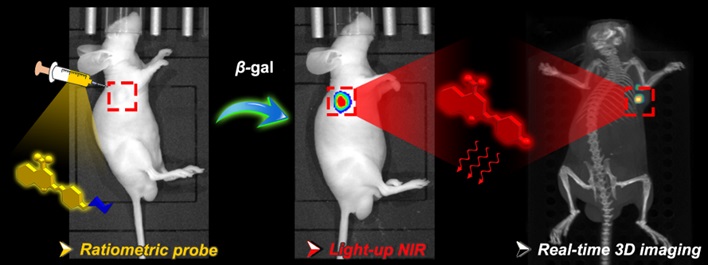Near-infrared functional dyes have been wide and potential applications in biomedicine research, especially for early stage of disease diagnosis and therapy in vivo owing to their rapid, safety, and non-invasiveness. Recently, Wei-Hong Zhu’s group make a new breakthrough in the near-infrared dye for in situ visualization of enzyme activity, and a paper titled “Real-Time Tracking and In Vivo Visualization of β‑Galactosidase Activity in Colorectal Tumor with a Ratiometric Near-Infrared Fluorescent Probe” has been published on J. Am. Chem. Soc. (http://pubs.acs.org/doi/abs/10.1021/jacs.6b01705). The research was mainly completed by doctoral student Kaizhi Gu and associate Prof. Zhiqian Guo, under the great help of Prof. Ping Shi from school of biotechnology.

As a typical enzyme, β-galactosidase (β-gal) has been demonstrated as an important biomarker for cell senescence and primary ovarian cancers. Researchers led by Prof. Zhu present a ratiometric and light-up NIR probe, in which the dicyanomethylene-4H- pyran (DCM) chromophore is utilized as a NIR-active fluorescence reporter and a β-gal cleavable unit is utilized as the enzyme-active trigger. The probe manifests significantly ratiometric and light-up NIR fluorescent signals simultaneously in response to β-gal concentration, realizing quantitative trapping of endogenous β-gal distribution in living cells. Impressively, the tumor site was precisely located in vivo and in situ using high-resolution three-dimensional fluorescence imaging for the first time.
In recent years, Prof. Zhu’s group has published a series of papers about the function and stability of organic dye, such as J. Am. Chem. Soc.2016, DOI:10.1021/jacs.6b01705; J. Am. Chem. Soc. 2016, 138, 2219; Advanced Materials, 2016, DOI: 10.1002/adma.201504782; J. Am. Chem. Soc., 2015, 137, 8490; Angew. Chem. Int. Ed., 2015, 54, 7275; Angew. Chem. Int. Ed., 2014, 53, 4603; J. Am. Chem. Soc., 2014, 136, 3579; Angew. Chem. Int. Ed., 2014, 53, 2090; Chem. Soc. Rev., 2015, 44, 4179.
These research was financially supported by National 973 Program (No. 2013CB733700), NSFC for Creative Research Groups (No. 21421004), and NSFC for Distinguished Young Scholars (No. 21325625).




